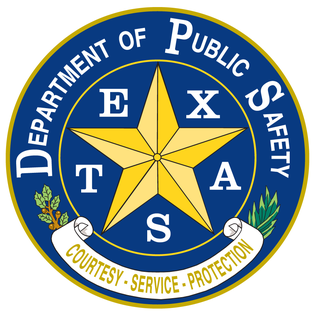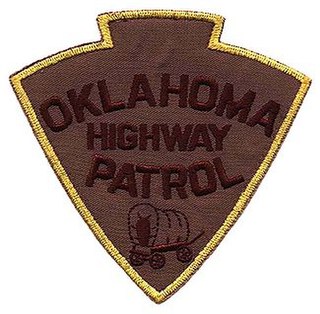
The Department of Public Safety of the State of Texas, commonly known as the Texas Department of Public Safety (DPS), is a department of the state government of Texas. The DPS is responsible for statewide law enforcement and driver license administration. The Public Safety Commission oversees the DPS. However, under state law, the Governor of Texas may assume command of the department during a public disaster, riot, insurrection, formation of a dangerous resistance to enforcement of law, or to perform his constitutional duty to enforce law. The commission's five members are appointed by the governor and confirmed by the Texas Senate, to serve without pay for staggered, six-year terms. The commission formulates plans and policies for enforcing criminal, traffic and safety laws, preventing and detecting crime, apprehending law violators, and educating citizens about laws and public safety.
Inspector, also police inspector or inspector of police, is a police rank. The rank or position varies in seniority depending on the organization that uses it.

The Jacksonville Sheriff's Office (JSO) is a joint city-county law enforcement agency, which has primary responsibility for law enforcement, investigation, and corrections within the consolidated City of Jacksonville and Duval County, Florida, United States. Duval County includes the incorporated cities of Jacksonville, Atlantic Beach, Baldwin, Jacksonville Beach, and Neptune Beach; the beach cities have their own police departments as well.

The Maryland State Police (MSP), officially the Maryland Department of State Police (MDSP), is the official state police force of the U.S. state of Maryland. The Maryland State Police is headquartered at 1201 Reisterstown Road in the Pikesville CDP in unincorporated Baltimore County.

The Fort Worth Police Department (FWPD) is the police department of Fort Worth, Texas, United States. Neil Noakes is the Chief of Police.

The Illinois State Police (ISP) is the state police agency of the state of Illinois. The Illinois State Police is responsible for traffic safety on more than 300,000 miles of total roadway, including 2,185 miles of Interstate Highways and 15,969 miles of State Highways. Currently, almost 3,000 sworn and civilian personnel make up the Illinois State Police.

The Columbus Division of Police (CPD) is the primary law enforcement agency for the city of Columbus, Ohio, in the United States. It is the largest police department in Ohio, and among the twenty-five largest in the United States. It is composed of twenty precincts and numerous other investigative and support units. Chief Elaine Bryant assumed leadership of the Division in 2021. Special units of the Columbus Division of Police include a Helicopter Unit, Canine Unit, Mounted Unit, Community Response Teams, Marine Park Unit, and Special Weapons and Tactics Team (SWAT).

The Oklahoma Highway Patrol (OHP) is a major state law enforcement agency of the government of Oklahoma. A division of the Oklahoma Department of Public Safety, the OHP has traffic enforcement jurisdiction throughout the state. OHP was legislatively created on July 1, 1937, due to the growing problem of motor vehicle collisions, the expansion of highway systems, and the increase in criminal activities.

The St. Louis County Police Department (SLCPD) is the primary and largest law enforcement agency serving St. Louis County in the U.S. state of Missouri. The current Chief of Police is Colonel Kenneth Gregory. According to the Charter of St. Louis County, the county police chief has all of the criminal law enforcement duties of the sheriff of St. Louis County, except for the operation of the St. Louis County Jail, which is handled by the St. Louis County Department of Justice Services (civilian), court bailiff and service of civil process. Court bailiff/civil process duties are provided by a court-appointed sheriff and his employees, none of whom have law enforcement powers.

The Cincinnati Police Department is the primary law enforcement agency of Cincinnati, Ohio. The department has 1,053 sworn officers and 119 non-sworn employees.

The Gaston County Police Department is a law enforcement agency of Gaston County, North Carolina, United States. It is 1 of only two county police agencies within the State of North Carolina(.)

The Cleveland Division of Police (CDP) is the governmental agency responsible for law enforcement in the city of Cleveland, Ohio.

The Florida Department of Law Enforcement (FDLE) is a state-wide investigative law enforcement agency within the state of Florida. The department formally coordinates eight boards, councils, and commissions. FDLE's duties, responsibilities, and procedures are mandated through Chapter 943, Florida Statutes, and Chapter 11, Florida Administrative Code. FDLE is headed by a commissioner who reports to the Florida Cabinet, which is composed of the governor, the attorney general, the chief financial officer, and the commissioner of agriculture. The commissioner is appointed to his position by the governor and cabinet and confirmed by the Florida Senate.
Akron Police Department is the primary municipal law enforcement agency for the city of Akron, Ohio, United States with 451 employees. The current Police Chief is Stephen L. Mylett.

The New York City Police Department (NYPD) is structured into numerous bureaus and units. As a whole, the NYPD is headed by the Police Commissioner, a civilian administrator appointed by the Mayor, with the senior sworn uniformed officer of the service titled "Chief of Department". The Police Commissioner appoints the First Deputy Commissioner as the department's second-in-command and the Chief of Department as the department's highest ranking uniformed officer. The commissioner also appoints a number of deputy and assistant commissioners who do not have operational command and are solely for support and administrative function. The department is divided into twenty bureaus, six of which are enforcement bureaus. Each enforcement bureau is further subdivided into sections, divisions, and units, and into patrol boroughs, precincts, and detective squads. Each bureau is commanded by a bureau chief. There are also a number of specialized units that are not part of any of the bureaus and report to the Chief of the Department.
The Columbia Police Department (CPD) is the principal law enforcement agency serving the city of Columbia, Missouri in the United States. It protects a metropolitan population of nearly 127,000 with 187 sworn police officers.
Earl Daniel Woodyard Jr. was a longtime Pittsburgh Police leader, who was appointed acting Pittsburgh Police Chief from September 29, 2006 – October 31, 2006, after the death of mayor Bob O'Connor.

Robert J. Contee III is the former Chief of the Metropolitan Police Department of Washington, D.C., United States. He was appointed by Mayor Muriel Bowser as acting chief effective January 2, 2021, and was confirmed unanimously by the DC Council on May 4, replacing Peter Newsham. He retired from the Metropolitan Police Department on May 31, 2023.

The Cocoa Police Department (CPD) is the primary law enforcement agency for the city of Cocoa, Florida, and is accredited through the state of Florida. The department services approximately 19,000 residents within 15.41 sq miles of the municipality. The department also serves roughly 2,500 daily non-residents who commute to the municipality for employment.






















